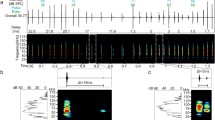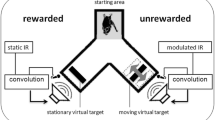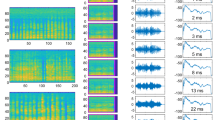Summary
Bats of the speciesNoctilio albiventris, trained to discriminate differences in target distance, emitted pairs of pulses at a rate of 7–10/s, the first a constant frequency (CF) pulse of about 8 ms duration and 75 kHz frequency, followed after about 28 ms by a CF/FM pulse having a 6 ms, 75 kHz CF component that terminates in a 2 ms FM sweep to about 57 kHz.
Loud free-running artificial pulses, simulating the bat's natural CF/FM echolocation sound, interfered with distance discrimination at repetition rates exceeding 5/s. Systematic modifications in the temporal and frequency structure of the artificial pulses resulted in orderly changes in the degree of interference. Artificial pulses simulating the natural CF or FM components alone had no effect, nor did 10/s white noise pulses, although constant white noise of the same intensity masked the behavior.
Interference occurred when the CF of the artificial pulses was between 52 and 77 kHz, ending with a downward FM sweep of 25 kHz from the CF. For interference to occur there was a much more critical requirement that the FM sweep begin at approximately the frequency of the CF component. The FM sweep needed to be 11 kHz or greater bandwidth. Interference occurred when the duration of the CF component of the CF/FM artificial pulse was between 2 and 30 ms, with maximal effect between 10 and 20 ms. However, a brief (2.0 ms) CF signal 2–27 ms before an isolated FM signal was as effective as a continuous CF component of the same duration.
When coupled with the bat's own emissions, artificial CF/FM pulses interfered if they occurred after the bat's CF/FM pulse and before the next natural emission. A 2 ms FM sweep alone was effective in interfering with distance discrimination when it came 8–27 ms after the onset of the bat's own CF/FM pulse. Neither CF/FM nor FM artificial pulses interfered when they began during the bat's own emission. A 10 ms CF pulse alone had no effect at any time.
These findings indicate thatN. albiventris uses both the CF and FM components of its short-CF/FM echolocation sound for distance discrimination. The CF onset activates a gating mechanism that, during a narrowly defined subsequent time window, enables the nervous system to process FM pulse-echo pairs for distance information, within a fairly broad frequency range, as long as the frequencies of the CF and the beginning of the FM sweep are nearly identical.
Similar content being viewed by others
Abbreviations
- CF :
-
constant frequency
- FM :
-
frequency modulation
References
Feng AS, Simmons JA, Kick SA (1978) Echo detection and target ranging neurons in the auditory system of the batEptesicus fuscus. Science 202:645–648
Gellerman LW (1933) Chance disorders of alternating stimuli in visual discrimination experiments. J Genet Psychol 42:205–208
Goldman LJ, Henson OW (1977) Prey recognition and selection by the constant frequency bat,Pteronotus p. parnellii. Behav Ecol Sociobiol 2:411–420
Griffin DR (1958) Listening in the dark. Yale University Press. New Haven; Dover Press, New York
Grinnell AD (1963) The neurophysiology of audition in bats: Temporal parameters. J Physiol (Lond) 167:67–96
Grinnell AD (1967) Mechanisms of overcoming interference in echolocating animals. In: Busnel RG (ed) Animal sonar systems. Lab Physiol Acoust, Jouy-en-Josas, France, pp 451–481
Grinnell AD (1970) Comparative auditory neurophysiology of neotropical bats employing different echolocation signals. Z Vergl Physiol 68:117–153
Grinnell AD (1973) Neural processing mechanisms in echolocating bats, correlated with differences in emitted sounds. J Acoust Soc Am 54:147–156
Grinnell AD, Griffin DR (1958) The sensitivity of echolocation in bats. Biol Bull 114:10–22
Grinnell AD, Hagiwara S (1972) Adaptations of the auditory nervous system for echolocation. Studies of New Guinea bats. Z Vergl Physiol 76:41–81
Henson OW Jr (1965) The activity and function of the middle ear muscles in echolocating bats. J Physiol (Lond) 180:871–887
Henson OW Jr (1967) The perception and analysis of biosonar signals by bats. In: Busnel RG (ed) Animal sonar systems. Lab Physiol Acoust, Jouy-en-Josas, France, pp 949–1003
Neuweiler G (1970) Neurophysiologische Untersuchungen zum Echoortungssystem der Großen HufeisennaseRhinolophus ferrumequinum Schreber 1774. Z Vergl Physiol 67:237–306
Neuweiler G, Schuller G, Schnitzler HU (1971) On-and-off-responses in the inferior colliculus of the greater horseshoe bat to pure tones. Z Vergl Physiol 74:57–63
O'Neill WE, Suga N (1979) Target range-sensitive neurons in the auditory cortex of the mustache bat. Science 203:69–73
O'Neill WE, Suga N (1982) Encoding of target range information and its representation in the auditory cortex of the mustache bat. J Neurosci 2:17–31
Pollak GD, Henson OW Jr, Novick A (1972) Cochlear microphonic audiograms in the ‘pure tone’ batChilonycteris parnellii. Science 176:66–68
Pollak GD, Marsh D, Bodenhamer R, Southers A (1977) Characteristics of phasic-on neurons in inferior colliculus of unanesthetized bats with observations relating to mechanisms of echo ranging. J Neurophysiol 40:926–942
Roverud RC (1984) Echolocation sound structure and information requirements for distance discrimination in the bat,Noctilio albiventris. PhD thesis, University of California, Los Angeles
Roverud RC, Grinnell AD (1985) Discrimination performance and echolocation signal requirements for target detection integration and distance discrimination in the CF/FM bat,Noctilio albiventris. J Comp Physiol A 156:447–456
Schnitzler HU (1968) Die Ultraschall-Ortungslaute der Hufeisen-Fledermäuse (Chiroptera-Rhinolophidae) in verschiedenen Orientierungssituationen. Z Vergl Physiol 68:25–39
Schnitzler HU (1970a) Echoortung bei der FledermausChilonycteris rubiginosa. Z Vergl Physiol 68:35–38
Schnitzler HU (1970b) Comparison of the echolocation behavior inRhinolophus ferrumequinum andChilonycteris rubiginosa. Bijdr Dierk 40:77–80
Schnitzler HU (1978) Die Detektion von Bewegung durch Echoortung bei Fledermäusen. Verh Dtsch Zool Ges 1978:16–33
Schnitzler HU, Flieger E (1983) Detection of oscillating target movements by echolocation in the Greater Horseshoe bat. J Comp Physiol 153:385–391
Schnitzler HU, Henson OW Jr (1980) Performance of airborne animal sonar systems: I. Microchiroptera. In: Busnel RC, Fish JF (eds) Animal sonar systems. Plenum Press, New York, pp 109–181
Schnitzler HU, Menne D, Rudi K, Heblich K (1984) The Acoustical Image of Fluttering Insects in Echolocating Bats. In: Huber F, Markl H (eds) Neuroethology and behavioral physiology. Roots and growing points. Springer, Berlin Heidelberg New York, pp 235–250
Schuller G (1972) Echoortung beiRhinolophus ferrumequinum mit frequenzmodulierten Lauten. Evoked potentials im Colliculus inferior. J Comp Physiol 77:306–331
Schuller G (1980) Hearing characteristics and Doppler shift compensation in South Indian CF/FM bats. J Comp Physiol 139:349–356
Simmons JA (1973) The resolution of target range by echolocating bats. J Acoust Soc Am 54:157–173
Simmons JA, Howell BJ, Suga N (1975) Information content of bat sonar echoes. Am Sci 63:204–215
Simmons JA, Vernon JA (1971) Echolocation: Discrimination of targets by the batEptesicus fuscus. J Exp Zool 176:315–328
Suga N (1969) Classification of inferior colliculus neurons of bats in terms of responses to pure tones, FM sounds and noise bursts. J Physiol (Lond) 200:555–574
Suga N (1970) Echo-ranging neurons in the inferior colliculus of bats. Science 170:449–452
Suga N (1977) Amplitude spectrum representation in the Doppler-shifted-CF processing area of the auditory cortex of the mustache bat. Science 196:64–67
Suga N, Jen PH-S (1976) Disproportionate tonotopic representation for processing CF-FM sonar signals in the mustache bat auditory cortex. Science 194:542–544
Suga N, O'Neill WE (1979) Neural axis representing target range in the auditory cortex of the mustache bat. Science 206:351–353
Suga N, Schlegel P (1973) Coding and processing in the auditory systems of FM-signal-producing bats. J Acoust Soc Am 54:174–190
Suga N, Schlegel P, Shimozawa T, Simmons J (1973) Orientation sounds evoked from echolocating bats by electrical stimulation of the brain. J Acoust Soc Am 54:793–797
Suga N, O'Neill WE, Manube T (1978) Cortical neurons sensitive to combinations of information bearing elements of biosonar signals in the mustache bat. Science 200:778–781
Suga N, O'Neill WE, Kazuro K, Manube T (1983) Specificity of combination-sensitive neurons for processing of complex biosonar signals in the auditory cortex of the mustached bat. J Neurophysiol 49:1573–1626
Sullivan WE (1982) Neural representation of target distance in auditory cortex of the echolocating batMyotis lucifugus. J Neurophysiol 48:1011–1032
Suthers RA (1965) Acoustic orientation by fish-catching bats. J Exp Zool 1158:319–348
Wenstrup J (1984) Auditory sensitivity in the fish-catching bat,Noctilio leporinus. J Comp Physiol A 155:91–101
Wenstrup J, Suthers R (1984) Echolocation of moving targets by the fish-catching bat,Noctilio leporinus. J Comp Physiol A 155:75–89
Author information
Authors and Affiliations
Rights and permissions
About this article
Cite this article
Roverud, R.C., Grinnell, A.D. Echolocation sound features processed to provide distance information in the CF/FM bat,Noctilio albiventris: evidence for a gated time window utilizing both CF and FM components. J. Comp. Physiol. 156, 457–469 (1985). https://doi.org/10.1007/BF00613970
Accepted:
Issue Date:
DOI: https://doi.org/10.1007/BF00613970




